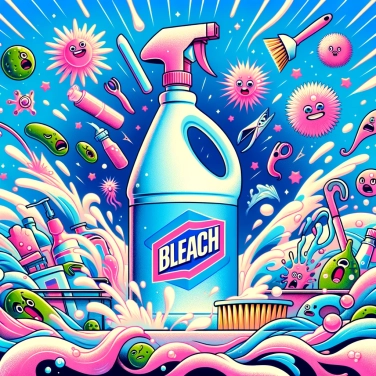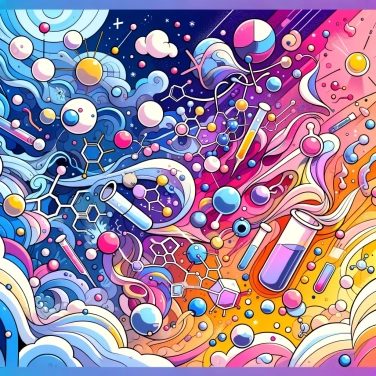Bleach is a powerful disinfectant because of its ability to release active chlorine, which is a strong oxidizing agent capable of destroying microorganisms such as bacteria, viruses, and fungi.

Bleach is mainly made up of a molecule called sodium hypochlorite, obtained by mixing chlorine into a solution of caustic soda. It has a very pale yellow-green color in its pure state, but it is often used so diluted that it appears almost transparent like water. Its particularity is that it easily releases active chlorine, a hyper-reactive compound that attacks and destroys germs within minutes. It has a strong chlorine smell, a rather sharp odor reminiscent of swimming pools, and is capable of whitening fabrics by breaking down the pigments responsible for colors. Practically speaking, it is very effective even in small doses. However, it degrades over time, especially when exposed to light and heat, so it is best to check the expiration date.
Bleach works primarily due to the active chlorine it releases upon contact with water. This active chlorine directly targets microorganisms by penetrating their outer membrane and then disrupting their internal proteins. As a result, bacteria, viruses, and fungi are eliminated very effectively. At low concentrations, bleach rapidly destroys the majority of common germs, which is why it is so widely used for cleaning. However, be cautious, as some very resistant germs may survive longer, hence the importance of adhering to the correct dosage and contact time.
Concentration is essential: if the bleach is too diluted, it kills microbes less effectively. Conversely, if it is too concentrated, it becomes corrosive without necessarily disinfecting better.
Temperature also plays a role: cold water limits its disinfecting power, while hot water significantly accelerates its action against germs.
Contact time is crucial: it's useless to scrub quickly; you need to let the bleach work for a few minutes to be truly effective.
Finally, the initial cleanliness of the surface also matters a lot. On a dirty surface or one full of residues, the bleach can be partially neutralized and will not be completely effective.
Bleach is often used to effectively disinfect surfaces that come into contact with food in the kitchen, such as countertops, sinks, or cutting boards, to prevent the spread of bacteria like salmonella. It is also widely used for disinfecting toilets and bathrooms, as these areas are particularly conducive to microbial growth. Another typical example is in swimming pool water, where bleach is used to eliminate viruses, bacteria, and algae. Medical facilities also frequently rely on its disinfecting properties to sanitize premises, medical equipment, and various tools, in order to prevent the spread of healthcare-associated infections. Finally, during an epidemic, bleach is used to disinfect commonly touched household surfaces, such as doorknobs, light switches, and remote controls, thereby limiting the spread of contagious diseases.
Bleach is effective, but it can be aggressive to the skin or eyes. Wear gloves and protect your eyes to avoid any unpleasant irritation. Be especially careful never to mix bleach with other chemical products like ammonia or vinegar, as this produces very dangerous toxic gases. Always use it in a well-ventilated room to avoid irritating fumes. And of course, keep it out of reach of children as its ingestion is extremely toxic. Finally, be careful with delicate surfaces or textiles, because bleach can severely discolor.
Contrary to popular belief, increasing the concentration of bleach does not necessarily improve its disinfecting effectiveness; adhering to the recommended concentrations is sufficient for optimal disinfection.
Mixing bleach with vinegar or other acidic products releases toxic chlorine fumes; therefore, it is important to use this product alone and in a well-ventilated area.
Light and heat can reduce the effectiveness of bleach; to preserve its disinfecting properties, store it in a cool, dark place and out of reach of children.
Although very effective at eliminating bacteria and viruses, bleach is not very effective on very dirty or greasy surfaces. Therefore, it is necessary to clean the surfaces before any disinfection for better effectiveness.
Yes, bleach, when released in large quantities, can have negative effects on aquatic ecosystems due to its aggressive chemical nature. It is important to use it responsibly, to limit excessive discharges, and to prioritize a reasonable domestic use to reduce environmental pollution.
The bleach used in domestic settings is generally less concentrated than that used in hospital or industrial environments, where strict hygiene and disinfection requirements often necessitate a higher concentration. Hospital protocols precisely regulate its use to ensure maximum disinfection.
No, it is strongly advised against mixing bleach with other chemical products such as vinegar or ammonia. This mixture can produce very dangerous toxic fumes for health. Always use bleach on its own according to the manufacturer's instructions.
Bleach is very effective against many viruses, bacteria, and fungi, but may have limited efficacy against certain particularly resistant microorganisms, such as bacterial spores. For these specific cases, particular protocols must be followed (extended contact time, specific concentration).
Yes, in certain exceptional circumstances, bleach (unscented and without additives) can be used to make water potable in emergency situations. However, it is essential to strictly adhere to the recommended doses (usually a few drops per liter of drinking water), wait the necessary contact time, and always refer to official guidelines before proceeding.
Yes, bleach has a limited shelf life. Over time, especially when exposed to heat, light, or air, it gradually decomposes and loses its disinfecting power. Be sure to regularly check the expiration date of your product and store it properly.

No one has answered this quiz yet, be the first!' :-)
Question 1/5